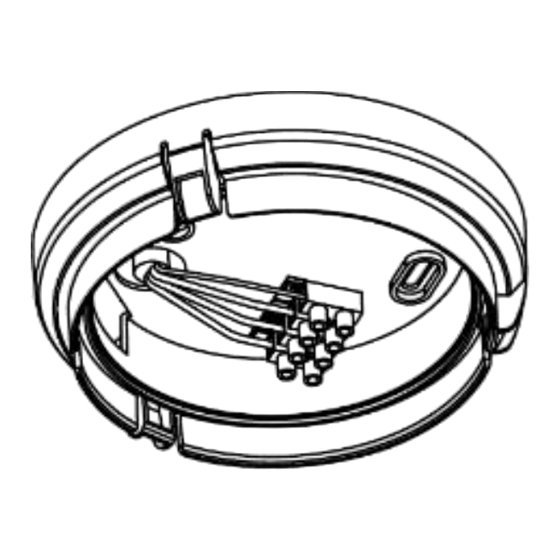Advertisement
Quick Links
Description
Combined Optical Smoke and Heat Alarms with a 10-year sealed for life
battery back-up. The alarms mount onto a wiring base.
Multiple combined alarms can either be hardwired or wirelessly interlinked
together. Combined Optical Smoke and Heat Alarms (1171) can be
hardwired linked to other alarms within the series e.g. 1163, 1164, 1169.
The combined alarm can be wirelessly linked with a RF switch for remote
testing and silencing.
Where to Locate
Combined or Smoke alarms need to be installed in circulation areas of a
dwelling, for example, hall ways and landing, as a minimum, and ideally
heat alarms need to be installed in kitchens, as required by BS 5839-6,
Code of Practice for the design, installation, commissioning and
maintenance of fire detection and fire alarm systems in domestic
premises.
Ideally, Combined or Smoke alarms should be located:
•
In living and sleeping areas.
•
On each floor of the dwelling.
•
In every room where electrical appliances are operated, e.g. portable
heaters, tumble dryers.
•
In each room where there are fossil fuel burning appliances, e.g. gas
boilers, cookers, fireplaces.
It may be necessary to install more than one Combined or Smoke alarm in
an area, e.g. in halls/corridors that are more than 9m long. See diagram 1.
Positioning of Alarms
•
Smoke and heat from and burning materials rise to the ceiling and
spread horizontally. Mounting the smoke alarm on the ceiling in the
centre of the room places it closest to all points in the room. Ceiling
mounting is preferred in ordinary residential dwellings.
•
If smoke alarms are not positioned centrally on a ceiling within a
room, it is recommended to locate it a minimum of 300mm (12")
from the side wall (see Diagram 2).
1
P a g e
Diagram 1
300mm Minimum
Recommended
Diagram 2
User and Installation Instructions Manual
Combined Optical Smoke and Heat Alarm 240V with 10 Year Battery Back-Up
Alarms suitable for BS 5839-6 requirements for Grade D systems.
All products must be installed by a competent person in accordance BS
7671, the current edition of the IET Wiring Regulations.
•
Put a Combined or Smoke alarm at both ends of a hallway/corridor or
large room if it is more than 9000mm (30') long.
•
In rooms with an A-shaped peaked ceiling, a sloped or cathedral
ceiling, install a Combined/smoke/heat alarm between 500mm and
1500mm from the highest point of the ceiling. (See Diagram 3).
•
To limit false alarms as laid within BS 5839-6, it is recommended that
smoke alarms should not be installed within 900mm (3') of the
following: the door to a kitchen, the door to a bathroom containing a
tub or shower. If space restrictions prevent this, it must not be
located closer than 300mm (12") from the side wall.
•
Also, alarms should be positioned away from forced air supply ducts
used for heating or cooling, ceiling or whole house ventilating fans, or
other high air flow areas to limit false alarming.
•
It is recommended that smoke alarms are not installed within 300mm
of light fittings.
•
If positioning the alarm in the loft space, it must be easily accessible.
Ideally, from the loft hatch.
•
Ideally, where possible, mount the alarm on a horizontal surface in
the loft space.
Do Not Install Combined or Smoke Alarms in the Following Places
•
Alarms should not be positioned in hard-to-reach areas, such as
above stairwells, that make it difficult to gain access for maintenance
•
In unventilated garages as vehicle exhaust fumes may cause false
alarm.
•
In an area where the temperature may fall below 0
o
40
C, such as garages and unfinished attics.
•
In dusty areas. Dust particles may cause nuisance alarm or failure to
alarm.
•
In very humid areas (greater than 93% R.H.), e.g. bathrooms.
Moisture or steam can cause nuisance alarms.
•
In insect-infested areas.
•
Near fluorescent lights. Electronic "noise" may cause nuisance
alarms.
Important:
These alarms are primarily intended for use in single
family occupancy private dwellings.
1171
and RF linkable
Diagram 3
o
C or rise above
Advertisement

Summary of Contents for Deta 1171
- Page 1 Multiple combined alarms can either be hardwired or wirelessly interlinked 7671, the current edition of the IET Wiring Regulations. together. Combined Optical Smoke and Heat Alarms (1171) can be hardwired linked to other alarms within the series e.g. 1163, 1164, 1169.
- Page 2 This alarm must not be connected to any other manufacturer alarms. • The combined Smoke and Heat alarm is compatible with DETA item numbers, 1163, 1165, 1164 and 1166 and 1169; and can be hardwired interlinked with these alarms. It is not compatible with the previous generations.
- Page 3 Battery property. In addition, it is possible for the alarm to fail at any time. 1171 model has a sealed 10-year battery and must not be replaced. For this reason, you must test the alarm monthly and replace unit after 10 years.
- Page 4 Deta Electrical Company Ltd UK: Panattoni Park Luton Road Chalton Bedfordshire LU4 9TT P a g e EU: Unit 16 Ashbourne Ind. Est. Ashbourne Co. Meath A84 W972 deta.co.uk | Technical Helpline: +44(0)1582 544 548 2531 8504 INS0289 V1.0 03/23 NPD 0733...

Need help?
Do you have a question about the 1171 and is the answer not in the manual?
Questions and answers